You are here
A Peak Behind the Curtain
A Peak Behind the Curtain
When is it worth protecting a wetland or enacting a new safety regulation? Writ large, what is the role of government in promoting and protecting public welfare? Regardless of our political orientation in these divisive times, few would oppose basic government standards for electrical wiring in our homes or in the service of food safety, right?
But how much is enough or too much?
There is a nested suite of issues and assumptions that often go largely unexamined in the debate about the value of environmental protection and whether it supports or constrains economic growth. Let’s look at them one at a time.
On language
Since language both reflects and drives thinking, the words we use matter; they define the frameworks we apply to the world around us. And seemingly simple words such as “worth,” “value,” and “price” are often used interchangeably when they mean quite different things.
Price, an economic term, describes the numeric indicator of something for sale in the marketplace – a number that allows a buyer and seller to communicate. It is not, however, the same as value which brings into the equation ethical and moral considerations that might or might not be reflected in economic price.
And “worth” adds yet another layer of complexity. My view of what something is worth may be quite different from yours. The higher price a hotel might charge for a room with an ocean-view versus one with a view of the dumpster might be worth it for you because you are going to spend a lot of time in the room. For me (since I am only sleeping in the room), I don’t care about the view. We value the same things differently.
Core Assumptions
The current paradigm for evaluating environmental (and other) public policy proposals posits market failure as the driver for government intervention. We typically presume that the market, while imperfect, will nonetheless generally serve the public interest with modest government interventions. Over the long arc of history, however, that is very much a debatable proposition.
That the “free market” is the greatest mechanism for generating wealth and prosperity may well be true. But when we put either an equity, ecosystem, or time lens on this proposition it becomes very much a hypothesis rather than a statement of fact.
Leaving aside hard questions of morality and accountability, how well is public welfare served when 86% of all the wealth in the world is controlled by 10% of its people while the other 90% control only 14%?
How is the public welfare of future generations being served by the spread since World War II of persistent organic pollutants into every corner of the planet?
Whether long-term social welfare, globally, is best served by a loosely controlled marketplace or a more empowered government that truly creates a level-playing field for all actors in the marketplace is very much unclear.
And, at an even more fundamental level, the market/government duality obscures that prosperity and economic growth might not be the highest aspiration of a society. Entertain for just a moment the thought experiment that identifies equity or spiritual fulfillment as our highest social goal. Or, even more radically, what our world might look like if ending poverty was our core social goal around which policy, capital, and intellect were all united?
As a Practical Matter
Proponents of conventional thinking will assert that “as a practical matter” we need to price clean air, carbon emissions, fishing stocks, the value frogs contribute to ecosystem stability, and the agricultural value of pollinators like bees. While inarguably useful and important, the danger here is in how we assign value, who the “we” is that does the assigning, and whether we lose something that is invaluable in our efforts to monetize nature in order to protect her.
Before we become too attached to current practice, let’s remember that before Copernicus it was the practical consensus that the sun rotated around the earth; and it seemed crazy to consider renting your apartment to a total stranger before AirBnB’s business model. What seems impractical one day can become commonplace the next.
Our thinking is not sometimes but almost always limited by our imagination and the intellectual and operational tools we deploy are very much time-bound. Whether measuring particulate pollution, designing QA (quality assurance) protocols for process engineering, or marveling at the expanding storage capacity of a chip, today’s KPIs (key performance indicators) bear little resemblance to those of a mere decade ago.
Declarations of what we “know” should be tempered with a large dose of humility.
Benefit/Cost Analysis
One of the most powerful tools in our measurement arsenal, benefit/cost analysis, is mandated across the government; it is the means by which we assess the value of the previously discussed government intervention to address market failure. It is, thus, an immensely powerful tool. And while as a tool it may be seen as neutral, “as a practical matter” it is subject to manipulation and misuse.
What goes in the benefit and what goes in the cost column when trying to devise a policy to address climate change? Closing high emitting coal-fired power plants sounds great—unless you are a coal miner. The benefits of fracking once seemed to obviously outweigh the costs—but that was before we understood the extent of methane leakage, water contamination and possible fracking-induced earthquakes.
In addition to the accounting challenge of capturing all the costs and benefits, there is also the equity/distributional challenge when deploying this widely used tool. When we provide agricultural subsidies in the U.S. to grow corn for ethanol or high fructose corn syrup, do we need to account for what impact this will have on smallholder farmers across the globe?
Even more challenging is the issue of how we account for unintended consequences and the passage of time. While economists and investors have a suite of tools for this, what is a reasonable time frame over which to calculate costs and benefits? If we are talking about the habitability of our planet, how far out should we look: a decade, a generation, one-hundred years? In agriculture, for example, what looks like a terrific plan for increasing short-term yields to feed a hungry population today may be disastrous a few decades from now—if it is predicated on mining the soil of nutrients until there are none left to mine.
Value of a human life
As noted at the outset, it is and should be a sense of public welfare that drives consideration of policy. And public welfare is about people, but what I do, singly, as an individual, may seem benign until 300 million other people do the same thing. Think littering. The public consequence of personal choice is at the center of many critical debates today: sugary beverages and public health, antibiotics and food, for example.
How we value human life is another critical element of this debate which rarely makes its way into the public discourse—because it is complex and ethically awkward. But it has implications for everything from wrongful death settlements in hospitals to the height of guard rails on public roads.
As part of cost/benefit analysis policymakers routinely assess the value of a human life and factor that in to how much we spend on safety. When a lawyer guides a client in a suit against a hospital for wrongful death, they will assess how much money a court might award the surviving family members. Analysts will look at indicators like lost earnings, the value of companionship, past and potential social contributions. And they will tell the surviving family members what they think is a reasonable “value” of the life just lost. It in no way represents the worth of the person. As a practical matter, it is nothing more than a price in the marketplace.
Risk
As with cost/benefit analysis more broadly, who bears the costs and who enjoys the benefits are central to the calculus.
The death of a patient is, for a hospital, a cost of doing business; it happens. It is handled by folks from “patient safety” who are tasked with “risk management.” For a family member, the patient and the risk are profoundly personal.
So too with climate change, sustainability, energy, water, and all environmental-related issues. Risk and the perception of risk is another critical element in this suite of issues that are submerged beneath so much of our public discussion.
Risk is the intersection of probability and consequence. Risk is where they meet. If you think you don’t make risk calculations, have you ever crossed the street against the light? You made a calculation at that practical and metaphorical intersection. Low probability and low consequence decisions are easy; not likely to happen and if it does, low consequence. No big deal. High probability and high consequence, like jumping into the ocean without knowing how to swim, also pretty easy. Bad idea.
The tougher challenges are obviously around situations where there is some probability and some consequence. And around those decisions, the underlying question of who bears the risk and who is protected from them is again central if overall public welfare is the goal.
As we continue to address the wicked complex challenges of our time, how we think about them may well determine the extent to which we can or cannot successfully address them. We are, like all civilizations before us, constrained by the tools and mindsets we have at our disposal. We are not, for example, well practiced systems thinkers; we have trouble envisioning alternative futures and pathways.
If we want different outcomes, we need to change the systems we have created. And that begins with expanding our thinking to embrace new paradigms and challenging our own most basic assumptions.


